Get the weekly SPARTANAT newsletter.
Your bonus: the free E-Book from SPARTANAT.

REVIEW: Raytheon ELCAN Specter Dr 1x/4x
An in-depth review of the Raytheon ELCAN Specter DR, a versatile combat sight offering both 1x for close range and 4x for long range. Detailed analysis, dimensions, adjustments, reticle, battery life, and performance on the AR platform. Design criticized for weight, mount, and eye relief, but praised for switch mechanism and versatility. A practical optic for modern combat scenarios, commonly used by military units.
Few optics have caused as much stir as the Raytheon ELCAN Specter DR. It was the first Combat Sight that offered both 1x for close range and 4x for long range in one device. Until then, there were only compromises like a red dot with magnifier, ACOGs with mini red dots on top, or regular scopes combined with red dots. We took a closer look at the device and tested it.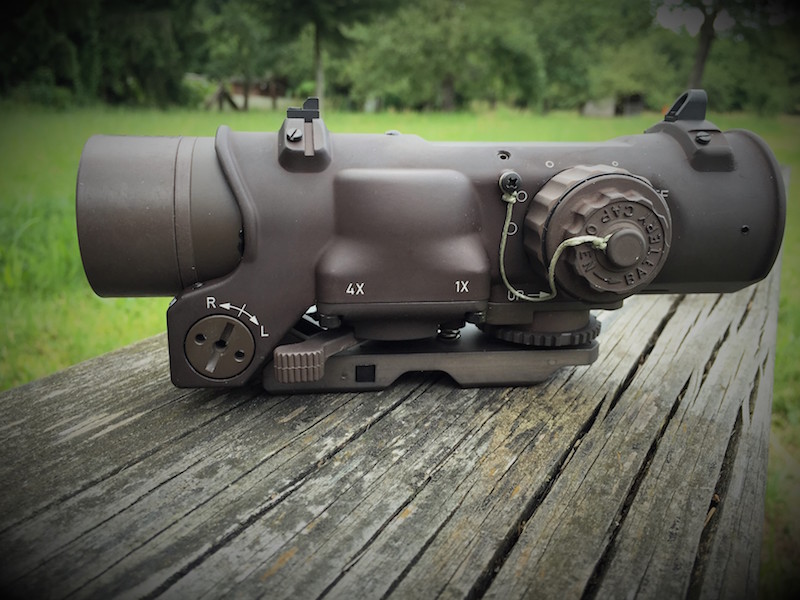 First of all, the compact design is noticeable. Compared to a red dot/magnifier combo or a regular scope, the ELCAN Specter is quite short - only 155mm long, making it perfect for the AR platform. The other dimensions are 72mm in width and 72mm in height.
First of all, the compact design is noticeable. Compared to a red dot/magnifier combo or a regular scope, the ELCAN Specter is quite short - only 155mm long, making it perfect for the AR platform. The other dimensions are 72mm in width and 72mm in height.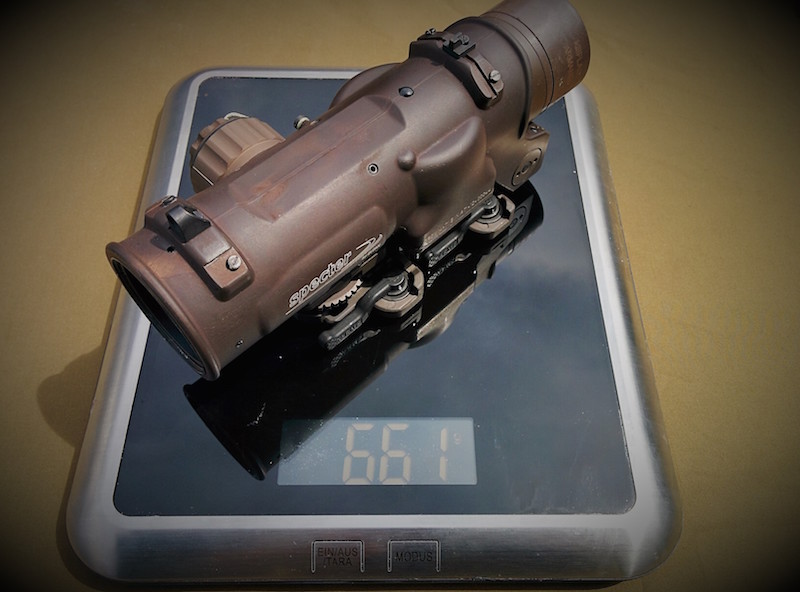 Oftentimes, the high weight of the device is criticized, and indeed, the measured 660 grams is not exactly lightweight - however, it is important to consider that the mount is already integrated and is included in the total weight. Thus, the Specter is only slightly heavier than a red dot/magnifier combo (about 500 grams with Aimpoint Micro and Aimpoint 3x Magnifier) and even scopes with RDS do not fare better. Only an ACOG is lighter, but it is also the worst option for close range, as there is no red dot present or it is positioned so high above the bore axis that it is difficult to manage.
Oftentimes, the high weight of the device is criticized, and indeed, the measured 660 grams is not exactly lightweight - however, it is important to consider that the mount is already integrated and is included in the total weight. Thus, the Specter is only slightly heavier than a red dot/magnifier combo (about 500 grams with Aimpoint Micro and Aimpoint 3x Magnifier) and even scopes with RDS do not fare better. Only an ACOG is lighter, but it is also the worst option for close range, as there is no red dot present or it is positioned so high above the bore axis that it is difficult to manage.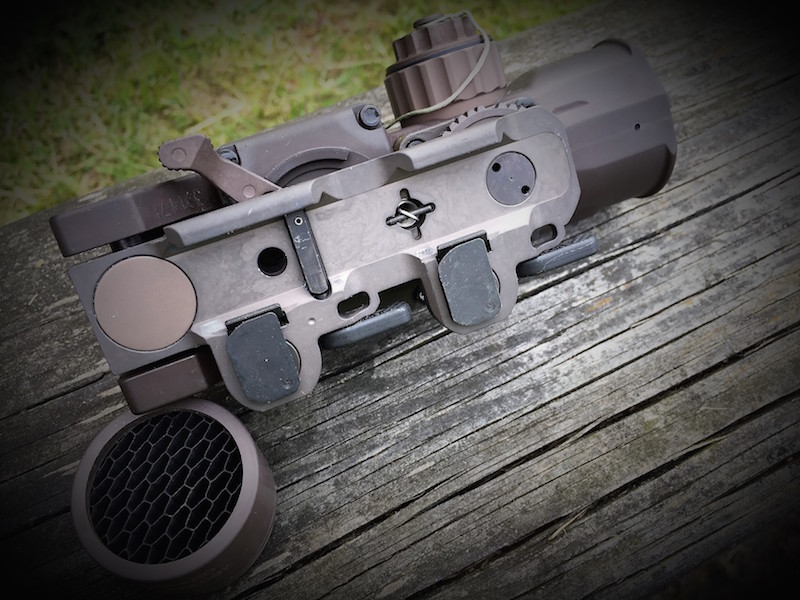 While we're on the topic of mounting: It comes from A.R.M.S. and is permanently fixed. This is often mentioned as a point of criticism, as A.R.M.S. has not exactly covered itself in glory in the past, and there were complaints about the ACOG mount not being repeatable. We could not find anything of the sort during our tests, with consistent shooting and multiple mountings/dismountings not resulting in any significant change in point of impact. The optic is mounted with two quick-release levers that have a firm grip and are best released with a piece of string or similar. Fingers do not really fit behind them.
While we're on the topic of mounting: It comes from A.R.M.S. and is permanently fixed. This is often mentioned as a point of criticism, as A.R.M.S. has not exactly covered itself in glory in the past, and there were complaints about the ACOG mount not being repeatable. We could not find anything of the sort during our tests, with consistent shooting and multiple mountings/dismountings not resulting in any significant change in point of impact. The optic is mounted with two quick-release levers that have a firm grip and are best released with a piece of string or similar. Fingers do not really fit behind them.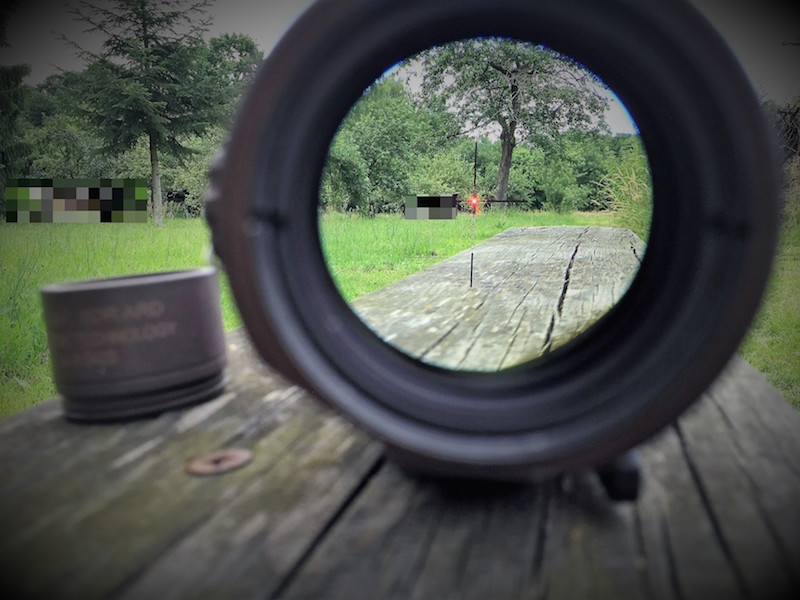 Under the optic, you will find the adjustment for the reticle at the rear and on the left side at the front. It can be adjusted +-60 MOA, using ½ MOA clicks. The windage adjustment is inside the housing, thus protected against accidental adjustment. The elevation adjustment is at the rear end (shooter's side) and can be secured over a small hook above it, so that nothing can unintentionally be moved there as well.
Under the optic, you will find the adjustment for the reticle at the rear and on the left side at the front. It can be adjusted +-60 MOA, using ½ MOA clicks. The windage adjustment is inside the housing, thus protected against accidental adjustment. The elevation adjustment is at the rear end (shooter's side) and can be secured over a small hook above it, so that nothing can unintentionally be moved there as well.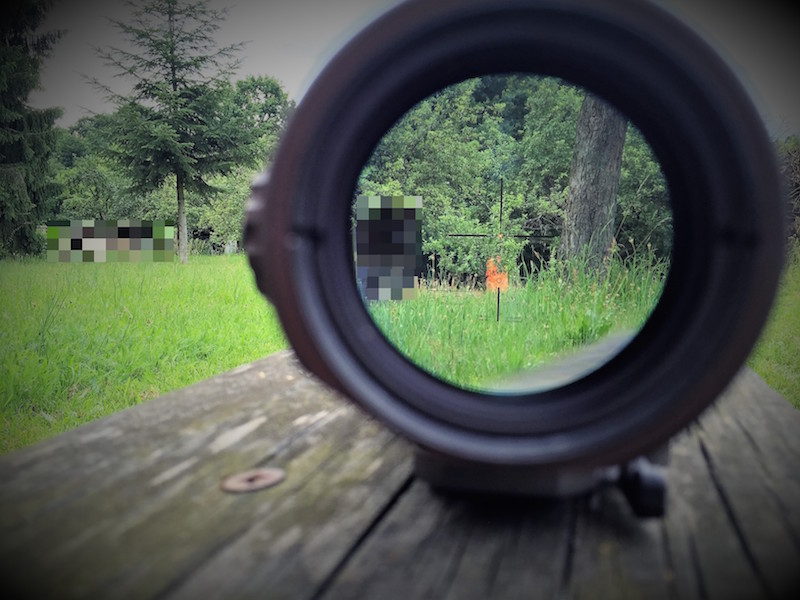 The reticle is a crosshair with Bullet Drop Compensator. When zeroed at 100 meters, the point in the center of the crosshair is the 100 meter target, and then there are aiming points for 300, 400, 500, and 600 meters. Beyond that distance, a circle with an indicated crosshair is used, which can be used from 700-1,000 meters. The width of the aiming lines corresponds to approximately 76cm at the specified distance. This is the average width of an adult male's torso and can be used for estimating distances at the specified ranges. The aiming point is 1.5 MOA on 1x and 6 MOA on 4x. The device we tested has a reticle for .223 REM/5.56, but you can also get an ELCAN Specter 1x/4x in 7.62x51mm/.308.
The reticle is a crosshair with Bullet Drop Compensator. When zeroed at 100 meters, the point in the center of the crosshair is the 100 meter target, and then there are aiming points for 300, 400, 500, and 600 meters. Beyond that distance, a circle with an indicated crosshair is used, which can be used from 700-1,000 meters. The width of the aiming lines corresponds to approximately 76cm at the specified distance. This is the average width of an adult male's torso and can be used for estimating distances at the specified ranges. The aiming point is 1.5 MOA on 1x and 6 MOA on 4x. The device we tested has a reticle for .223 REM/5.56, but you can also get an ELCAN Specter 1x/4x in 7.62x51mm/.308.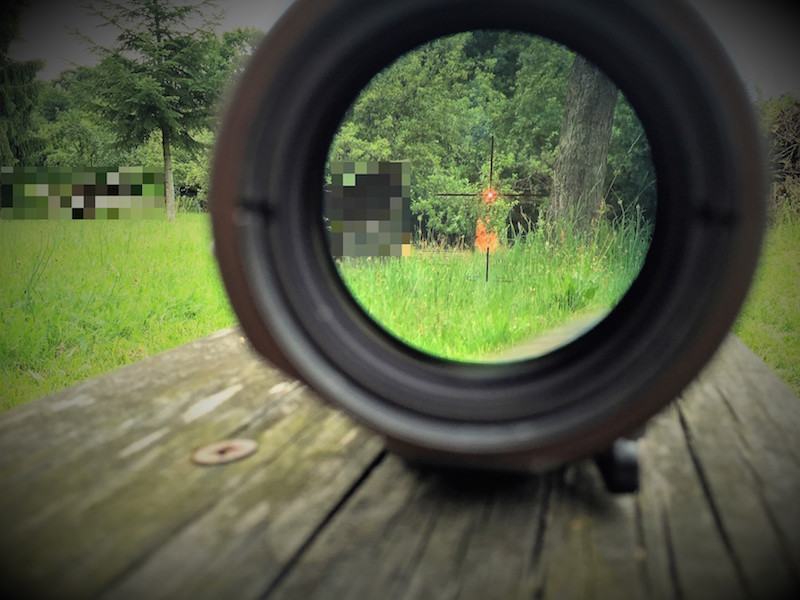 Also on the left side is the illumination control. It is quite large, but besides the battery (a fat DL 1/3N), it has two functions. Turning counterclockwise only illuminates the center point of the reticle. There are 5 brightness levels, with the first ones designed for night vision. The same applies when turning clockwise, but here the entire reticle is illuminated, including the crosshair and point. The battery life is rated at 600 hours on high brightness and 2,000 hours on medium brightness. If the battery needs to be changed, the waterproof cover is unscrewed, which is secured against loss with a retention strap.
Also on the left side is the illumination control. It is quite large, but besides the battery (a fat DL 1/3N), it has two functions. Turning counterclockwise only illuminates the center point of the reticle. There are 5 brightness levels, with the first ones designed for night vision. The same applies when turning clockwise, but here the entire reticle is illuminated, including the crosshair and point. The battery life is rated at 600 hours on high brightness and 2,000 hours on medium brightness. If the battery needs to be changed, the waterproof cover is unscrewed, which is secured against loss with a retention strap.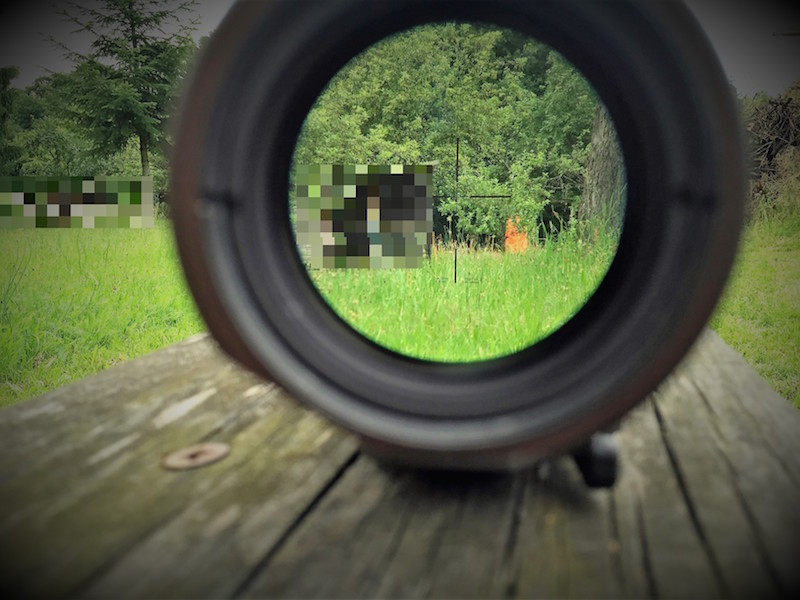 Next, the objective lens diameter catches our attention: it measures a full 32mm, the same size as a 4x32 ACOG and thus ideal for low light conditions. It also helps to maintain situational awareness. Field of view is also important, indicating the area visible through the lens at 100 meters. The Elcan offers 6.5° - only 0.5° less than the ACOG 4x32.
Next, the objective lens diameter catches our attention: it measures a full 32mm, the same size as a 4x32 ACOG and thus ideal for low light conditions. It also helps to maintain situational awareness. Field of view is also important, indicating the area visible through the lens at 100 meters. The Elcan offers 6.5° - only 0.5° less than the ACOG 4x32.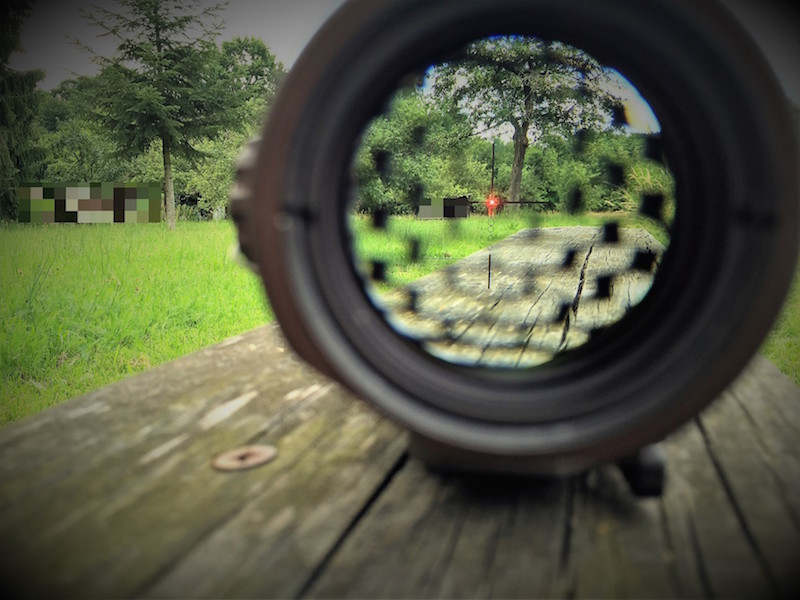 In terms of eye relief, the Elcan is unfortunately similarly poor - at least when shooting with 4x magnification. At 1x, there is an 80mm eye relief, while at 4x it is about half. This is also the reason why the optic is often seen mounted very far back on the weapon and typically without a backup iron sight.
In terms of eye relief, the Elcan is unfortunately similarly poor - at least when shooting with 4x magnification. At 1x, there is an 80mm eye relief, while at 4x it is about half. This is also the reason why the optic is often seen mounted very far back on the weapon and typically without a backup iron sight.
For emergencies, the ELCAN also has a backup sight on the top. Rear sight and front sight are present and can be set to 45° in both directions if needed, especially if you still have a mini RDS like the Docter mounted.
But the real magic is on the left side, in front of the illumination control: the switch between 1x and 4x. This is easy to operate - even with gloves - by unlocking the lever downward and then sliding it forward or backward. Inside the housing, the lens is simply swapped - from 1x to 4x or vice versa. This can be seen very well in the video and is, as mentioned before, quite ingenious. SPARTANAT is the online magazine for Military News, Tactical Life, Gear & Reviews. 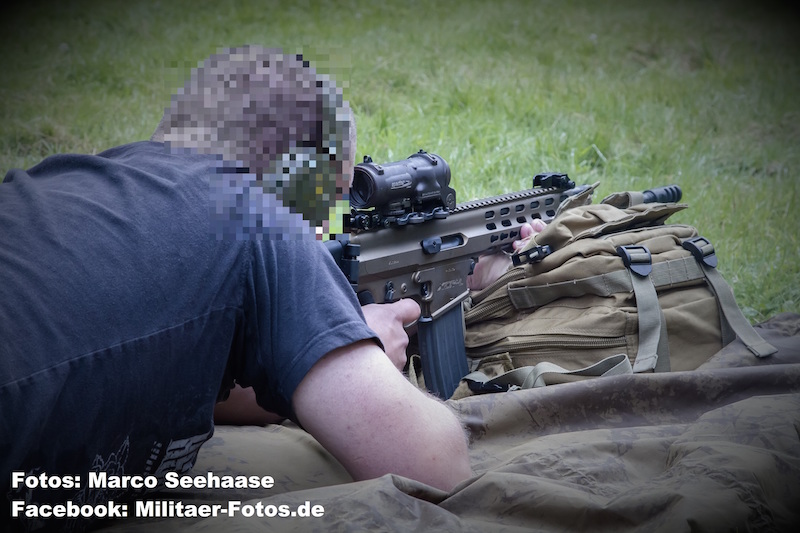 On the shooting range and the AR platform, the Specter DR performs well - whether in precision shooting with 4x magnification or at 1x with illumination as a red dot sight - both applications are well mastered and show that Raytheon has designed a quite useful optic. Used as a red dot, the field of view is not as fast as a real RDS like Aimpoint and certainly not like an EOTech, but in the modern battlefield of today where combat distances change rapidly from close to far and back again, it is an indispensable device. The ELCAN Specter 1x/4x variant is often seen on SOCOM M4s or SCAR L and H.
On the shooting range and the AR platform, the Specter DR performs well - whether in precision shooting with 4x magnification or at 1x with illumination as a red dot sight - both applications are well mastered and show that Raytheon has designed a quite useful optic. Used as a red dot, the field of view is not as fast as a real RDS like Aimpoint and certainly not like an EOTech, but in the modern battlefield of today where combat distances change rapidly from close to far and back again, it is an indispensable device. The ELCAN Specter 1x/4x variant is often seen on SOCOM M4s or SCAR L and H.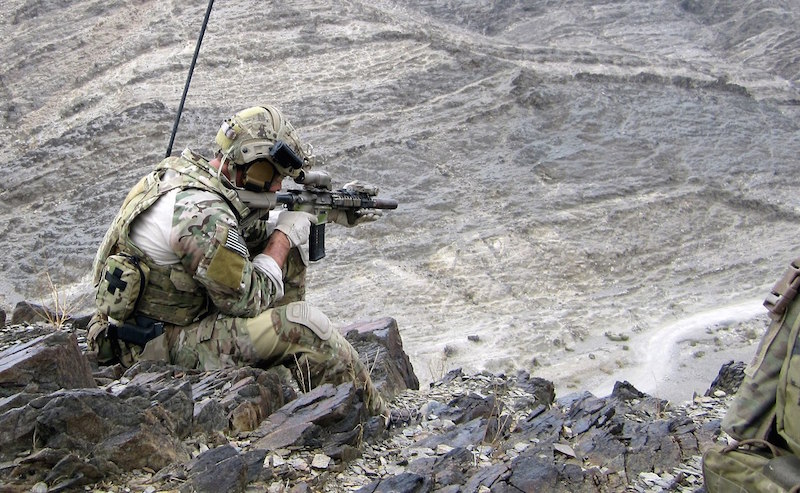
Send us your news: [email protected]
Ad
similar
Get the weekly SPARTANAT newsletter.
Your bonus: the free E-Book from SPARTANAT.


